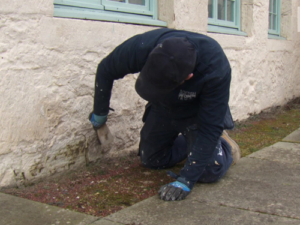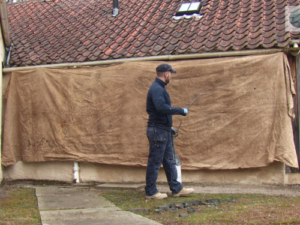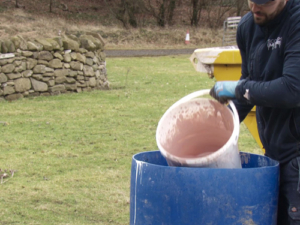This website uses cookies so that we can provide you with the best user experience possible. Cookie information is stored in your browser and performs functions such as recognising you when you return to our website and helping our team to understand which sections of the website you find most interesting and useful.
Some dos and don’ts in the use of lime mortars

Rosamond (Roz) Artis Director Scottish Lime Centre provides some top tips about the use of lime mortars.
Always work from the top down, so you are never working over finished work (an exception to this is grouting, which is a bottom upwards process).
When using hydraulic lime mortars always ensure they are kept damp for at least the first 72 hours after placing, this will ensure the hydraulic set is achieved.
Always work in temperatures of 5°C and rising (it’s 3°C for cement work) and not more than 30°C.
Protect your lime work from direct rainfall, frost (under insulated haps) and from the rapid drying effects of sun and wind.
If you notice your lime work is turning white very quickly, then it is drying out too quickly!
Important
The optimum curing conditions for hydraulic limes are 15-20°C and a Relative Humidity (RH) of 55-85%. If you have these conditions in place then your mortars will be fully cured at 90 days. Any conditions outwith these optimum conditions means your mortar will just take longer to achieve full curing (on the west coast of the UK the RH is much higher than the east coast).
- Cleaning down
- Dampening down
- Limewash Removal
Lime Pointing
When lime pointing, do not be tempted to ‘fill and finish’ in one go – wait for the mortar work to achieve a ‘leather hard’ stage whereby your thumb pressure does not leave an impression in the mortar but you can mark it with your thumb nail. Then it is ready for finishing.
For harling, rendering and pointing work, order in all the sand you are going to need in one go to be certain that it is consistent. Make sure you keep it in the same state throughout the job. Protect it from rainfall and contamination so your water dosage is the same for each mortar batch.
Keep buckets of limewash/lime paint agitated as the pigment is heavier than the lime and may sink to the bottom causing a variation in colour.
Limewashing
Like any good painting practice, keep a ‘wet edge’ and complete logical pieces of masonry ie up to breaks in masonry such as string courses, downpipes, internal or external angles. If there are no interruptions to the elevations you are limewashing, then you need to have sufficient operatives on the job to achieve coverage and adequate burnishing in one ‘hit.’
Limewash and lime paints can be sprayed on, but they must be burnished by hand to ensure even coatings and that no limewash or paint collects in lips or dips (especially with textured harling) otherwise these will crack and ‘chalk.’
Mask off historic glass when limewashing, as its high alkalinity can etch early glass. On larger limewashing jobs, place all the pre-made coloured limewash in a clean, plastic or metal drum, keep it agitated and everyone takes a bucket of limewash out of it – this reduces the risk of colour variation.
As limewash coatings are very thin (compared to mortars) be very vigilant about curing these slowly and keeping the hessian haps protection damp (most limewashes and paints are based on air limes – and so can only achieve stability and durability if they carbonate successfully – if they dry out too quickly they will not achieve carbonation and will simply dry to a dusty and chalky finish).
Best practice
Once you have established all your mortar mixes or received your specifications, do all the mortar mix calculations and put it into a simple table, photocopy it and make laminated copies for the site operatives to refer to.
In our experience the vast majority of mortar failures in lime work are the incorrect proportioning of materials and poor site practice in general in terms of curing and protecting the work adequately.
With thanks to the Scottish Lime Centre for providing this blog. The centre runs a range of courses throughout the year, from traditional building skills for repair and conservation, as well as masterclasses from beginner to advanced level and beyond. For more information please visit: www.scotlime.org
Become a member
Members of the Building Limes Forum form a community of lime enthusiasts and practitioners, most of whom are producers, suppliers, specifiers or users of lime.
Useful documents
Contact Building Limes Forum
Building Limes Forum
Riddle’s Court
322 Lawnmarket
Edinburgh, EH1 2PG, UK





